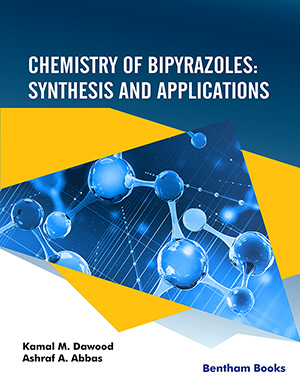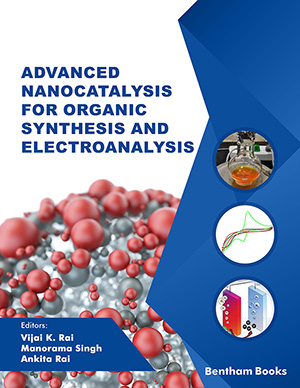
Abstract
Electrochemical oxidation of 4–methylesculetin has been studied in the presence of arylsulfinic acids as nucleophiles in aqueous/ acetonitrile solution mixture, using cyclic voltammetry and controlled-potential coulometry. The results indicate that the o-quinone derived from oxidation of 4–methylesculetin undergoes a 1,6–Michael addition reaction with unique selectivity, converts to the corresponding new sulfone derivative of esculetin. The reaction products were derived with good yields and excellent selectivity based on electrochemical oxidation under controlled potential conditions at a carbon electrode in an undivided cell.
Keywords: 4-Methylesculetin, 1, 6-Michael addition, arylsulfinic acids, cyclic voltammetry, electrochemical synthesis.
Current Organic Chemistry
Title:Electro-Organic Synthesis of New Esculetin Derivatives Based on 1,6-Conjugate Addition
Volume: 17 Issue: 8
Author(s): Hamid Salehzadeh, Mohammad Rafiee, Davood Nematollahi and Hadi Beiginejad
Affiliation:
Keywords: 4-Methylesculetin, 1, 6-Michael addition, arylsulfinic acids, cyclic voltammetry, electrochemical synthesis.
Abstract: Electrochemical oxidation of 4–methylesculetin has been studied in the presence of arylsulfinic acids as nucleophiles in aqueous/ acetonitrile solution mixture, using cyclic voltammetry and controlled-potential coulometry. The results indicate that the o-quinone derived from oxidation of 4–methylesculetin undergoes a 1,6–Michael addition reaction with unique selectivity, converts to the corresponding new sulfone derivative of esculetin. The reaction products were derived with good yields and excellent selectivity based on electrochemical oxidation under controlled potential conditions at a carbon electrode in an undivided cell.
Export Options
About this article
Cite this article as:
Salehzadeh Hamid, Rafiee Mohammad, Nematollahi Davood and Beiginejad Hadi, Electro-Organic Synthesis of New Esculetin Derivatives Based on 1,6-Conjugate Addition, Current Organic Chemistry 2013; 17 (8) . https://dx.doi.org/10.2174/1385272811317080010
| DOI https://dx.doi.org/10.2174/1385272811317080010 |
Print ISSN 1385-2728 |
| Publisher Name Bentham Science Publisher |
Online ISSN 1875-5348 |
Call for Papers in Thematic Issues
Catalytic C-H bond activation as a tool for functionalization of heterocycles
The major topic is the functionalization of heterocycles through catalyzed C-H bond activation. The strategies based on C-H activation not only provide straightforward formation of C-C or C-X bonds but, more importantly, allow for the avoidance of pre-functionalization of one or two of the cross-coupling partners. The beneficial impact of ...read more
Electrochemical C-X bond formation
Conventional methods for carrying out carbon–X bond formation are typically conducted at harsh reaction conditions, and rely on expensive catalysts as well as the use of stoichiometric, and perhaps toxic, oxidants. In this regard, electrochemical synthesis has recently been recognized as a sustainable and scalable strategy for the construction of ...read more
From Lab Bench to Algorithm: The Future of Organic Chemistry Powered by AI
Organic chemistry, with its intricate dance of molecules and reactions, is undergoing a transformation fuelled by the power of Artificial Intelligence (AI) and Machine Learning (ML). The integration of AI/ML with Organic Chemistry is revolutionizing the field by enhancing the efficiency and accuracy of chemical research and development. These technologies ...read more
N-Heterocyclics: Synthesis, Computational Studies, and Coordination Chemistry - A synthetic perspective
N-heterocycles, such as phenanthroline, quinoline, or their organometallic complexes, are widely used in a variety of fields, including chemistry, biochemistry, and coordination chemistry. They play a key role in many chemical and biological processes as biological ligands, medicinal agents, catalysts in organic synthesis, molecular probes and sensors, as well as ...read more
Related Journals
 32
32
- Author Guidelines
- Graphical Abstracts
- Fabricating and Stating False Information
- Research Misconduct
- Post Publication Discussions and Corrections
- Publishing Ethics and Rectitude
- Increase Visibility of Your Article
- Archiving Policies
- Peer Review Workflow
- Order Your Article Before Print
- Promote Your Article
- Manuscript Transfer Facility
- Editorial Policies
- Allegations from Whistleblowers
- Announcements
Related Articles
-
Cu-mediated synthesis of 2,3-dihydro-1H-pyrrolo[3,2,1-ij]quinolin-1-ones as potential inhibitors of sirtuins
Letters in Drug Design & Discovery NLRP3 Inflammasome Activation Inhibitors in Inflammation-Associated Cancer Immunotherapy: An Update on the Recent Patents
Recent Patents on Anti-Cancer Drug Discovery Science Ph.D. and Science Postdoctoral Advisors for the 21st Century: A Path To Successful Technology Transfer
Technology Transfer and Entrepreneurship (Discontinued) Epigenetics and Periodontal Disease: Hope to Tame the Untameable
Current Gene Therapy Sorafenib (BAY 43-9006): Review of Clinical Development
Current Clinical Pharmacology Ameliorative Effect of α-Tocopherol and Selenium on Effects of Malathion on Plasmatic Biochemical Indices and Lesions in the Liver of Rats
Current Pharmaceutical Analysis Recent Patents Relating to Tumor Suppressor Genes
Recent Patents on DNA & Gene Sequences Epigenetic Modulators as Treatment Alternative to Diverse Types of Cancer
Current Medicinal Chemistry Therapeutic Strategies for Alzheimer's and Parkinson's Diseases by Means of Drug Delivery Systems
Current Medicinal Chemistry Properties and Therapeutic Potential of Transient Receptor Potential Channels with Putative Roles in Adversity: Focus on TRPC5, TRPM2 and TRPA1
Current Drug Targets Identification of KEY lncRNAs and mRNAs Associated with Oral Squamous Cell Carcinoma Progression
Current Bioinformatics D Allele Frequency in Insertion/Deletion Polymorphism of the Angiotensin Converting Enzyme (ACE) Gene is Associated with Development of Breast Cancer Risk in Indian Women
Current Proteomics Pharmacogenomic Approaches for Tailored Anti-Leukemic Therapy in Children
Current Medicinal Chemistry Withdrawal Notice: EnzyPha, an Engineered Helper Phage Developed to Overcome Most of the Limitations Regarding Filamentous Phage Titration and ELISA Tests
Protein & Peptide Letters Dietary Phytochemicals in Cancer Signalling Pathways: Role of miRNA Targeting
Current Medicinal Chemistry CDC25A: A Rebel Within the CDC25 Phosphatases Family?
Anti-Cancer Agents in Medicinal Chemistry Recent Patents in Cell-Based Strategies for Soft Tissue Engineering in Plastic and Reconstructive Surgery
Recent Patents on Biomedical Engineering (Discontinued) Apoptosis Induction by Erucylphosphohomocholine via the 18 kDa Mitochondrial Translocator Protein: Implications for Cancer Treatment
Anti-Cancer Agents in Medicinal Chemistry Breast Cancer Targeted Treatment Strategies: Promising Nanocarrier Approaches
Anti-Cancer Agents in Medicinal Chemistry Adiponectin: A Key Player in Obesity Related Disorders
Current Pharmaceutical Design





















